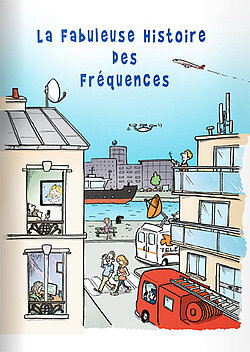The electromagnetic spectrum groups together all electromagnetic waves depending on their frequency, wavelength or energy. It is split into several main categories which each have their specificities.
The electromagnetic waves that compose the spectrum do not need a physical medium to move: we are permanently surrounded by an electromagnetic field in the same way as we are surrounded by air.
The frequency frieze is also on sale in our store (French version).
The main frequency categories
- Radio waves: from 3 Hz to 300 MHz. This category concerns the lowest frequency waves in the spectrum. Relatively easy to transmit and receive using antennas, radio waves are used to transmit information (radio and television, for example).
- Microwaves: from 300 MHz to 300 GHz. This category of waves uses slightly higher frequencies. They are unique in that they propagate like light and are not absorbed by the atmosphere as long as their frequency remains below 12 GHz. They are used for satellite transmissions, mobile phones, the Internet and microwave ovens.
- Above 300 GHz: wave fields that emit at higher frequencies, such as X-rays or gamma rays, are used for different purposes (radiography, food preservation, etc.), given their very high energy nature.
There is also a category of waves that is a little different: visible light. Indeed, all the waves that the human eye can see are part of a very small section of the electromagnetic spectrum. Just as the human ear cannot hear sounds that are too high or too low, our eyes cannot see rays with wavelengths shorter than 400 nm and longer than around 700 nm (or in terms of frequency, between 4.3x1014 and 7.5x1014 Hz).
The wave frequency also determines its colour: lower-frequency radiation is red, while higher-frequency radiation is blue and violet. This light can be manipulated using optical instruments: lenses, prisms, etc.
Given their many practical applications, entire economic sectors rely on access to electromagnetic frequencies: mobile communications, Digital Terrestrial Television, satellite links, transport, the military industry and the Internet of Things.
The National Frequency Agency’s role is to manage this spectrum, working closely with the assignment authorities, and more specifically the frequencies between 3 kHz and 300 GHz, covering both radio waves and microwaves.
It contributes to the development of international regulations and the demarcation of frequency bands at the national level, authorises and manages radio sites (from cell towers to radar), and monitors the proper use of the spectrum on a daily basis.
ANFR Académie
Questions about frequencies? The ANFR Académie proposes a series of educational videos intended to democratise the sometimes complex concepts associated with radio frequencies. These short videos are designed for the general public, using hard-hitting material and appropriate illustrations.
The fabulous history of frequencies
To mark the ANFR's 20th anniversary, and to illustrate the issues surrounding the spectrum, the ANFR presented a comic strip, "the fabulous history of frequencies", which illustrates the boom in wireless uses, from the discovery of electromagnetism to the present day.
This comic book is now available in our online store. To buy it and discover the fabulous history of frequencies, visit our store.



